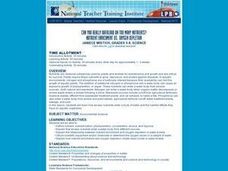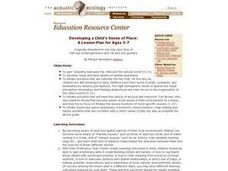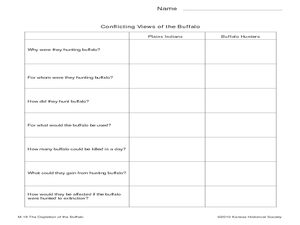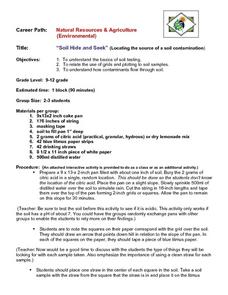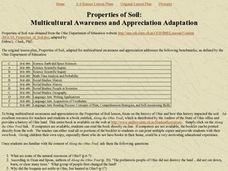Curated OER
The Warmth of the Sun
Young scholars compare and discuss the warmth of the classroom in a variety of places. They chart the warmth of places inside, outside and a pan of water.
Curated OER
What's The Flow?
Students examine urban runoff and identify peak flows. They examine causes for different flow rates, and complete worksheets and a graph.
Curated OER
Watershed Management
Students investigate the concept of a watershed. They conduct research into the concept using a variety of resources. Students take a field trip to a local watershed to make observations. The outcome is a report concerning the outside...
Curated OER
Acid Rain
Students write paragraphs and color illustrations about acid rain. They color in where gases come from, where they mix, and where they return. They discuss where acids form in the atmosphere and list manmade sources of gases.
Curated OER
The Romans: Public Health and Water
In this Ancient Rome worksheet, students read about the public health system of Ancient Rome: aqueducts, public baths and sewers.
Curated OER
Modeling Oil and Gas Reservoirs
High schoolers investigate energy by researching how oil reservoirs work. In this fossil fuels instructional activity, students conduct an experiment using a half full bottle of water, corn oil and oxygen, recording their data as the...
Curated OER
Nutrient Enrichment vs. Oxygen Depletion
Students investigate how excess nutrients enter a body of water, and the harmful effects they have on aquatic organisms.
Curated OER
Protecting Habitats and Species
Students recognize that scientists continuously gather and interpret data to understand and predict relationships among natural phenomena. They research various volcanoes and plot the volcano locations on a world map.
Curated OER
Watercycle
Third graders examine the natural circulation of water from oceans, lakes, and rivers to evaporation into the air, and then to condensation to produce rain falling back to the soil as components of the water cycle.
Curated OER
Living in a Watershed
Fourth graders examine watersheds. In this ecosystem lesson, 4th graders discover what a watershed is and identify the local watershed they live in. Students investigate the attributes of a watershed as well.
Curated OER
Developing a Child's Sense of Place
Students develop empathy with the natural world; visual and aural senses of spatial awareness; and initiate sound and space awareness, movement, indoor/outdoor, map-making and nature activities that correlate with a child's sense of play.
Curated OER
Erosion
Fifth graders study what erosion is, what causes it, and ways to slow its progress. They complete an experiment that depicts soil moving down a slope as water is poured on it to show how moving water erodes land. Next, they observe...
Curated OER
Native Versus Exotic
Students investigate the presence of exotic and natural species in the ecosystem. They define the differences between exotic and native while looking at one specific ecosystem in Maryland. They write how the exotic species are considered...
Curated OER
Earth Day - Bursting Beans
Students fill jars with dried beans and water, cover the jars, and wait to see what happens in this excellent Science experiment ideal for Earth Day (April 22nd). Emphasis is placed on discovering the reactions of seeds to water.
Curated OER
"Pandemic" A Disease Simulation
Students use small test tubes with water, salt and a silver nitrate solution to simulate the spread of infectious disease contracted the exchange of bodily fluid. They problem solve to track the original source of infection.
Curated OER
The Depletion of the Buffalo
Seventh graders consider different cultural viewpoints. In this Kansas history instructional activity, 7th graders examine the depletion of buffalo as a contention point between Native American and European settlers. Students read diary...
Curated OER
Watching the Weather
Students examine the weather. They discover the conflict between man and nature caused by the changes in weather and the impact it has upon their lives. Students explore weather folklore. They write a report on the weather. ...
Curated OER
"Soil Hide and Seek"
Pupils comprehend the basics of soil testing. They relate the use of grids and plotting to soil samples. Students comprehend how contaminants flow through soil. They discuss factors such as: slope of the pan, time, and the amount of...
Curated OER
Fighting Disease
Seventh graders explore the concept of medical intervention in African nations. In this geography lesson, 7th graders research primary and secondary sources in search of information regarding Guinea worm disease. Students use their...
Curated OER
Classification of Clouds
Students view a cloud slide show presentation and identify types of clouds. They estimate height based on cloud's appearance. They discuss the vague nature of cloud nomenclature and compare it to the English standard measurement system.
Curated OER
Properties of Soil
Students use history to create knowledge of how soil has changed in the state of Ohio. The lesson is cross curricular in nature and uses Along the Ohio Trail as a source of literature for reflection.
Curated OER
Habitat Hopscotch
Students analyze different habitats. In this habitat instructional activity, students evaluate what animals need in their habitats. Students participate in the game Habitat Hopscotch.
Curated OER
The Story Of American Freedom
Learners investigate the concept of American freedom with the use of primary sources of images in order to derive meaning. The images are used to inspire research and writing about historical scenes. The writing and analysis of the...
Curated OER
Causal Patterns in Density Phenomena
Young scholars investigate the relationship between volume and mass in different liquids such as vegetable oil, rubbing alcohol and water. They measure the mass of several different volumes of each liquid and then graph the results as...








